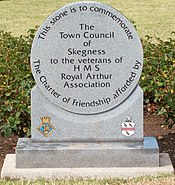| HMS Royal Arthur (shore establishment) | |
|---|---|
 The Petty Officer in charge meets trainee Belgian sailors as they arrive at HMS Royal Arthur, Skegness, Lincolnshire. | |
| Career (UK) | |
| Name: | HMS Royal Arthur |
| Commissioned: |
22 September 1939 (at Skegness) 2 January 1947 (at Corsham) |
| Decommissioned: |
1946 (Skegness) 1 April 1950 (Corsham) |
| Fate: |
Name transferred to Camp Kingsmoor in 1950 Kingsmoor closed on 5 March 1992 |
| General characteristics | |
| Class & type: | Stone frigate |
HMS Royal Arthur was a shore establishment of the Royal Navy, initially at Ingoldmells near Skegness (53°10′39″N 0°21′02″E / 53.1776206°N 0.3505325°E), and later at Corsham, Wiltshire (51°24′49″N 2°12′54″W / 51.4134742°N 2.2149897°W).
Skegness[]
The first Royal Arthur was previously a Butlins holiday camp and was commissioned as a training establishment on 22 September 1939. It served during the Second World War, becoming the central reception depot for new naval entries after HMS Raleigh was transferred to the Army in February 1944. Royal Arthur continued in service until being paid off in 1946.
Corsham[]
The establishment was recommissioned on 2 January 1947 in Westwells Road, Corsham as a leadership training establishment, and one of several assessment camps where new recruits were assessed, kitted out and sent to their various depots.[1] Its most notable trainee was the then Philip Mountbatten, shortly before his wedding to Princess Elizabeth.[2]
The last recruits arrived on 31 October 1949 and on 15 March 1950 it ceased to be used for training National Service inductees and concentrated on leadership training of Petty Officers at the instigation of Lord Louis Mountbatten.[1][3] The name was then transferred to the recently paid off Camp Kingsmoor on 16 March 1950. The camp continued in service until the last trainees left on 11 December 1992 and personnel finally left on 5 March 1993.[4]
The site has suffered heavy vandalism since its abandonment, although there have been proposals for redevelopment as a retirement village.[5] Plans to redevelop or demolish the site have been hampered by the presence of asbestos.
Gallery[]
References[]
Footnotes[]
- ↑ 1.0 1.1 "POST-WAR CHRONOLOGY OF ROYAL NAVY EVENTS, Part 1 - 1946-50". http://www.naval-history.net/xGM-Ops-Events1946-50.htm. Retrieved 2008-08-15.
- ↑ "My life with the Duke". Gazette and Herald. 22 February 2008. http://archive.salisburyjournal.co.uk/2008/2/22/367780.html. Retrieved 2008-08-15.
- ↑ "Correspondences between Lord Mountbatten and Gerhard Stamer and Werner Lott, 1946 - 1978". http://www.u-35.com/mountbatten/index.html. Retrieved 2008-08-15.
- ↑ "House of Commons Hansard Debates for 17 Jul 1991". HMSO. http://www.parliament.the-stationery-office.com/pa/cm199091/cmhansrd/1991-07-17/Debate-1.html. Retrieved 2008-08-04.
- ↑ "Support for £100m retirement plan". Wiltshire Times. 14 February 2008. http://archive.swindonadvertiser.co.uk/2008/2/14/366325.html. Retrieved 2008-08-15.
Further reading[]
- Warlow, Ben, Shore Establishments of the Royal Navy, Liskeard : Maritime, 2000. ISBN 978-0-907771-73-9
External links[]
The original article can be found at HMS Royal Arthur (shore establishment) and the edit history here.


